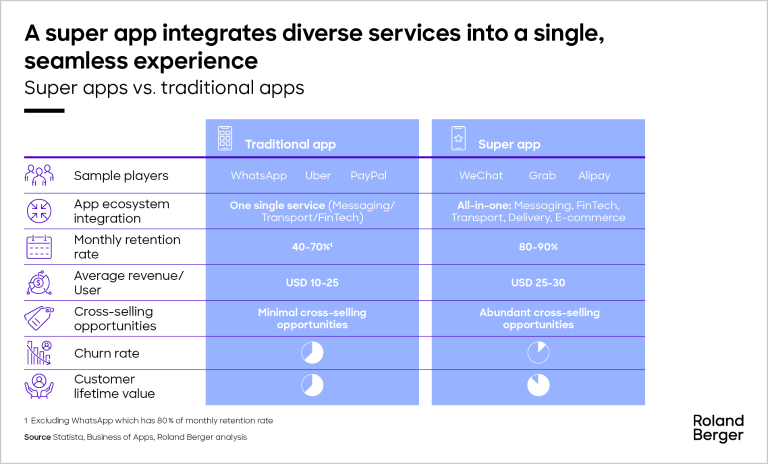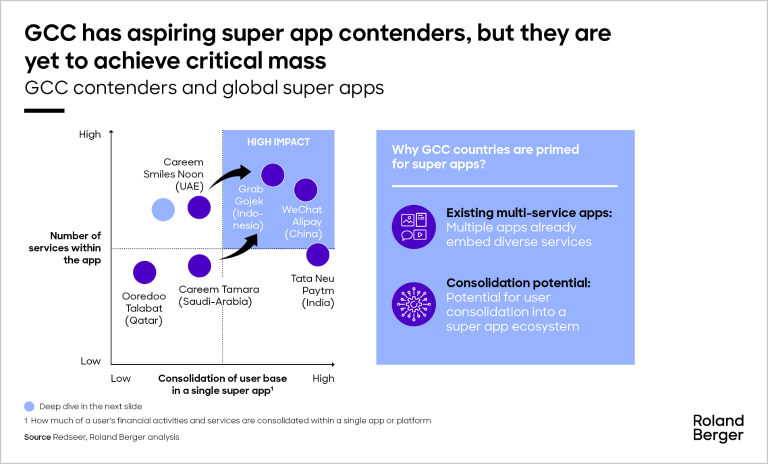Discover why Saudi Arabia is poised to become the leading data center hub in the Middle East. Learn about KSA's strategic investments, cutting-edge infrastructure, and visionary initiatives driving its dominance. Unlock the potential of Saudi Arabia's data center market and understand how KSA is transforming into a crucial player in the digital economy.


The Super App revolution in the Middle East
By Jawad Shaikh and Chetan Anand
On the cusp of superness
The rise of Super Apps has revolutionized digital ecosystems across Asia, with platforms such as China's WeChat amassing more than 1.3 billion active users and Southeast Asia's Grab and Gojek serving hundreds of millions. These platforms have transformed everyday tasks into seamless, integrated experiences, making them indispensable in the lives of their users. By contrast, the Middle East has yet to see the emergence of a true Super App – despite smartphone penetration leading the world in countries such as the United Arab Emirates (99%), Saudi Arabia (95%) and Qatar (91%). We examine key factors driving the use of Super Apps in the Middle East and the strategic paths that companies can take to scale successfully. We also look at what they can learn from global leaders. By addressing these dynamics, we believe that potential Super Apps in GCC countries can position themselves at the forefront of the digital transformation, unlocking new growth opportunities.

"Super Apps redefine digital interactions by consolidating multiple functionalities within a single, seamless platform, creating an interconnected digital ecosystem that enhances engagement and drives monetization."
The Super App model: Transforming digital interactions
Super Apps redefine the way users interact with digital services by consolidating multiple functionalities within a single, seamless platform. Unlike traditional applications that serve specific, isolated needs such as ride-hailing, mobile payments or food delivery, Super Apps integrate these services under one umbrella, creating an interconnected digital ecosystem. This integration enhances user retention, reduces friction in daily transactions and drives engagement through embedded financial services, social networking and e-commerce.
Super Apps typically scale through one of two strategic models: engagement-led or revenue-led. The engagement-led model prioritizes user stickiness and high daily active users (DAUs) before layering in monetization strategies. WeChat exemplifies this model, having first established itself as a dominant messaging platform before embedding payments, gaming and e-commerce to sustain long-term engagement. The revenue-led model, on the other hand, focuses on direct monetization from the outset through transaction fees, premium subscriptions, advertising and commissions. Alipay, for example, built its Super App ecosystem around financial services, prioritizing payments as its core revenue driver. The key advantage of the engagement-led model is its ability to build strong user loyalty and high-frequency interactions, which later translate into monetization opportunities through embedded services; however, the model requires significant upfront investment and patience before achieving profitability. The revenue-led model, by contrast, ensures immediate monetization and sustainability but often faces challenges in maintaining long-term user engagement if the services offered do not create habitual usage. Some Super Apps, such as Grab and Gojek, have adopted hybrid approaches, balancing engagement and monetization strategies to achieve sustainable growth.
"Unlike traditional applications that serve isolated needs, Super Apps seamlessly integrate services such as payments, ride-hailing, e-commerce and social networking, offering unparalleled convenience and user retention."
The journey to become a Super App typically starts with an "anchor" service with a high velocity of usage, such as messaging or ride-hailing. Once a strong user base is established, the platform extends into complementary verticals that enhance the core offering. The final stage can involve geographic expansion, with Super Apps replicating their success in new markets by adapting to local requirements and behaviors.
The GCC offers an attractive landscape for Super Apps due to its high rates of digital adoption and affluent consumer base. Yet, despite these favorable conditions, the market remains highly fragmented, with separate apps catering to ride-hailing, payments, e-commerce and government services. Leading contenders offer multiple services but none has reached full Super App dominance. In addition to digital-first businesses, telecom operators are well positioned to capitalize on this opportunity, as they already serve a broad range of use cases and services. However, this strength is also their Achilles' heel, as their offerings remain fragmented, preventing them from fully consolidating services under a unified platform.
"Despite its advanced digital infrastructure, the GCC region has yet to witness a fully realized Super App, presenting an immense opportunity for telecom operators and tech companies to consolidate services under a unified ecosystem."
GCC telecom operators: Potential pioneers of the region's Super App transformation
GCC telecom operators are uniquely positioned to build Super Apps due to their extensive digital ecosystems, spanning payments, entertainment and media, connectivity and social engagement. Over the years, these players cos have expanded beyond traditional telecommunications services, launching standalone apps that cater to essential digital needs. Thus, e&'s fintech arm, e& money, facilitates digital payments and remittances, while stc Pay has become a dominant financial services platform in Saudi Arabia. Ooredoo, on the other hand, integrates digital payments with connectivity-driven services, offering a foundation for seamless financial transactions. In connectivity, all three telcos operate apps that allow users to manage mobile plans, pay bills and access telecom services, providing an always-on digital touchpoint. In social and entertainment, these players have also made significant strides – stc's Jawwy and Ooredoo's digital-first initiatives focus on youth engagement, while e& has invested in content streaming and media partnerships.
Given their vast app portfolios, GCC telcos may eventually consolidate these services under a unified Super App. This approach would enable them to exploit cross-selling opportunities, driving adoption across different verticals by incentivizing users to engage with multiple services within a single ecosystem. A unified platform would also allow telcos to enhance user retention and stickiness, as customers who rely on a single app for financial transactions, connectivity management and media consumption are less likely to switch providers. By fostering a seamless ecosystem lock-in, these Super Apps could transform telcos from service providers into digital lifestyle enablers, reducing churn and maximizing user lifetime value.
Telcos have a significant advantage over traditional Super App contenders: They already own vast customer bases, have access to telecommunications infrastructure and enjoy deep regulatory expertise, particularly in payments and financial services. Unlike standalone fintechs or e-commerce platforms that need to build trust from scratch, telcos can use their brand credibility to accelerate adoption. Additionally, their 5G and cloud investments enable them to offer differentiated digital services, such as immersive entertainment, AI-powered customer experiences and integrated IoT solutions. As they refine their digital strategies, GCC telcos thus have the potential to emerge as the region's leading Super App players, redefining how consumers interact with financial, entertainment, and communication services in a single, frictionless platform.

How can Roland Berger help?
Roland Berger is uniquely positioned to help businesses in the Middle East navigate the Super App revolution. Our expertise spans market assessment, strategy definition and execution support, enabling clients to master the complexities of developing a Super App. We help companies evaluate their current market position, craft the optimal business model, identify strategic partnerships and define the technological infrastructure necessary for success. Furthermore, we offer execution support, ensuring seamless implementation through governance frameworks, investment planning and stakeholder coordination.









